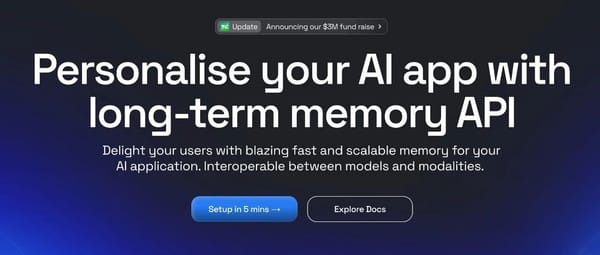Memory Challenge: Why Large Language Models Sometimes Forget Your Conversations
🚀 Ditch the Vibes — Get the Context
Ditch the vibes, get the context (Sponsored)

Your team is shipping to production — intuition alone isn’t enough.
Augment Code’s AI coding agent + industry‑leading context engine delivers production‑grade features while deeply understanding complex, enterprise‑scale codebases.
With Augment, your team can:
- 📚 Index & navigate millions of lines of code
- ⚡ Get instant answers about any part of your codebase
- 🤖 Automate processes across your entire dev stack
- 🧠 Build with an AI agent that understands your team + code
---
The Problem: AI “Forgetfulness” in Long Conversations
Imagine spending an hour with an LLM to debug code.
The AI is helpful — until you say “the error we discussed earlier” and… it asks for clarification or fabricates an answer.
This frustrating loss of context isn’t a temporary bug — it’s a fundamental architectural limitation in today’s LLMs.
Examples:
- Debugging: After exploring multiple solutions, the AI forgets the original problem.
- Technical discussions: Jumping topics (DB → API → DB optimization) breaks earlier references.
- Customer support: AI re‑asks questions already answered.
- Contextual phrases (“the function we discussed”) require re‑explaining details.
Understanding why this happens is critical for developers, creators, and AI product designers.
---
Context Windows: The Illusion of Memory
LLMs don’t “remember” — they work inside a fixed-size context window:
- Contains recent conversation tokens (text units)
- When full, older content is truncated (forgotten)
- Loss of early details is mechanical, not “forgetful”
Workarounds:
- Prompt engineering
- Conversation summarization
- External tools that re‑insert missing info
---
Stateless Design: How LLMs Process Conversations
LLMs reprocess the entire conversation history each time:
- Analogy: Reading a book from page 1 before writing the next sentence.
- Data size: Even 30,000 words ≈ 200–300 KB
- (smaller than a single photo)
- Bottleneck = computation, not transmission
Advantages:
- Any server can process any request
- Resilience: failover without losing state
- Easy horizontal scaling with load balancing
---
Token Limits: The “Notepad” Metaphor
Every LLM’s “notepad” (context window):
- Measured in tokens (~¾ of a word)
- Larger tokens for URLs, code, etc.
- Formatting (bullet points, line breaks) also consumes tokens
Modern limits:
- Small models: ~4k tokens (~3k words)
- Mid-range: 16k–32k tokens
- Largest: 100k+ tokens (≈ a novel) — but slow & expensive
---
Why We Can’t Just Make Context Windows Infinite
The Attention Mechanism
- Each token relates to every other token
- Computational complexity grows quadratically
GPU Memory Bottlenecks
- Longer input = massive relationship matrices
- Easily hits gigabytes of GPU memory usage
- Hardware ceilings prevent arbitrary expansion
Future:
- Memory‑efficient attention algorithms
- Retrieval‑based architectures
---
Retrieval-Augmented Generation (RAG): Making Context Feel Infinite
How RAG Works:
- Retrieve: Search external KB/docs for relevant info
- Inject: Place targeted excerpts into the LLM’s context
- Generate: AI answers using only the most relevant data
Benefits:
- Small context window → large effective knowledge base
- Avoids stuffing entire history or dataset into memory
Limitations:
- Retrieval requires clear context in questions
- Retrieved content must still fit inside the window
---
Key Takeaways
- LLMs are stateless — they re‑read context each turn, don’t “remember”
- Token capacity matters — affects cost, speed, and accuracy
- Context window size is limited by computational complexity & GPU memory
- RAG can help — expand effective context without huge token use
---
Practical Advice for AI-Powered Workflows
- Break complex problems into focused sessions
- Re‑introduce context when shifting topics
- Consider external memory tools + summarization
- Use multi-platform publishing ecosystems (e.g., AiToEarn) to preserve and monetize AI outputs
---
About AiToEarn
AiToEarn官网 is:
- Open-source global AI content monetization
- Generate → Publish → Monetize AI content
- Multi-platform: Douyin, Kwai, WeChat, Bilibili, Xiaohongshu, Facebook, Instagram, LinkedIn, Threads, YouTube, Pinterest, X
- Equipped with analytics & AI model ranking (AI模型排名)
- Works within AI limitations while scaling output
---
📢 Help Us Improve ByteByteGo
TL;DR: Take this 2-minute survey — help tailor ByteByteGo to your needs.
---
Sponsor ByteByteGo
Reach 1M+ tech professionals.
Spots sell out ~4 weeks ahead.
📧 sponsorship@bytebytego.com to reserve.
---
Tip: For creators & devs, AiToEarn connects AI content generation + analytics with simultaneous publishing, turning creativity into sustainable income.




